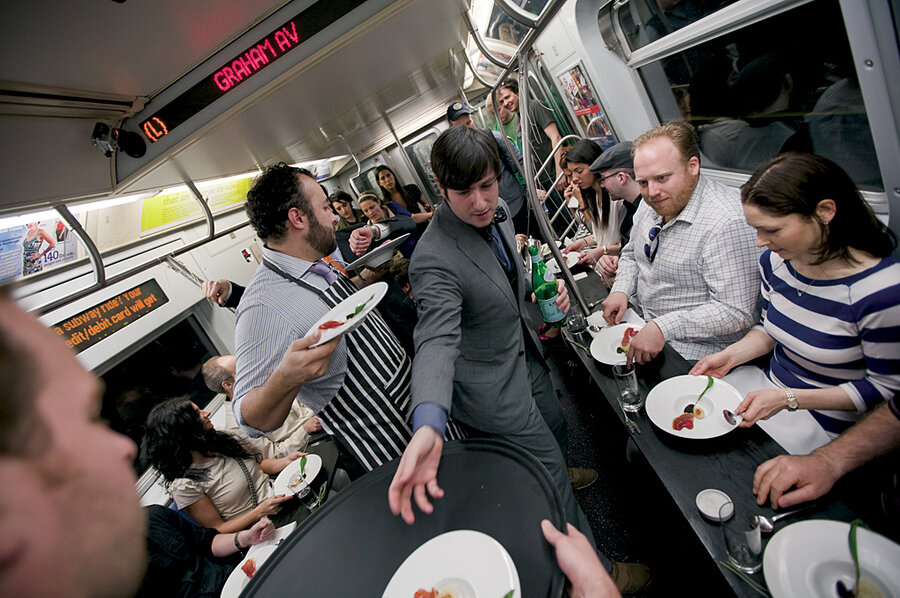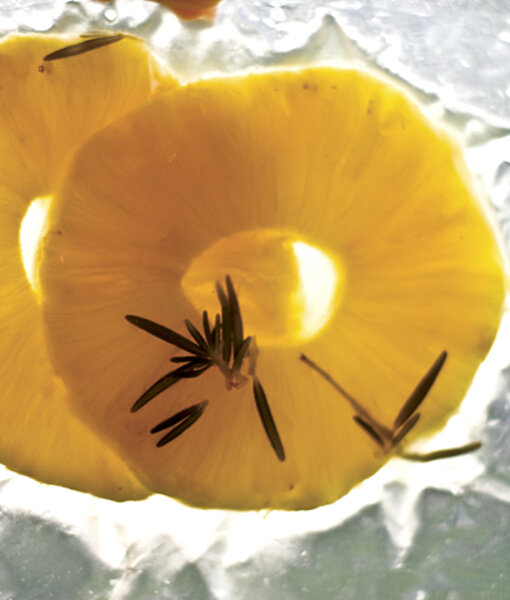The chef's art
Loading...
When Thai artist Rirkrit Tiravanija prepared curry on a hot plate for visitors to a SoHo gallery as his artwork "Untitled (Free)," it "was the launch of Rirkrit's career as a social sculptor," says Laura Hoptman, curator of painting and sculpture at the Museum of Modern Art in New York. The 1992 work also became, she adds, "one of the landmarks of what's come to be known as 'Relational Aesthetics.' "
The term, coined by French critic Nicolas Bourriaud in 1998, refers to art in which meaning is created through social exchange and audience participation. A culinary subset of this genre – in which artists prepare and serve food, using the meal as medium – has recently moved from the art world's back burner to the communal table. A successor to Modernism and Minimalism, call it "Mealism."
The recipe for this genre might go like this: Take a scoop of Happenings, a dash of conceptual art, and add a dollop of performance art. Sprinkle liberally into museums and galleries. Shake. Serve to the masses.
Until Feb. 8, visitors to MOMA can sample art they can sink their teeth into at a reinstallation of Mr. Tiravanija's seminal work now called "Untitled (Free/Still)." As the fragrance of coconut milk and cilantro wafts through the air, museum director Glenn Lowry notes, "Our olfactory sense tells us something unusual is happening in this gallery."
"It's not an object to be looked at that constitutes a work of art but an experience," chief curator of painting and sculpture Ann Temkin explains, adding, "The artist's role is to be a catalyst of that experience." For Maggie Wrigley, who polished off a bowl of curry after a conversation with strangers, it isn't just empty calories.
"It's switching the game around and surprising people," she says, "especially here in such an institution."
Hospitality as a medium ...
The Taiwan-born New York artist Lee Mingwei is at the forefront. "Most of my practice is about hospitality, generosity, and sharing," he said in a recent interview. He initiated "The Dining Project" in 1995 as an MFA student at Yale University, inviting strangers to dine with him. He recruited participants with posters asking for people interested in introspective conversation and food-sharing, telling volunteers, "Just bring your sense of joy and curiosity."
Mr. Lee has been called by Mr. Lowry "a social conceptualist whose medium is hospitality." The artist will re-create the one-on-one dining experience for an exhibition called "Feast: Radical Hospitality in Contemporary Art" at the University of Chicago's Smart Museum Feb. 16-June 10, 2012.
Stephanie Smith, curator of "Feast," explains why interest in this way of working has expanded like a soufflé: "It's connecting into the widespread interest in being more attentive about what and how we eat and with whom we eat." In addition to the increased number of artists using social activity as their medium, the emphasis on food reflects the popularity of celebrity chef shows on television; the locavore, slow-food, and sustainable-agriculture movements; as well as increased interest in the artisanal and domestic arts.
… and cake as a study in soil
For some artists, socially engaging art is an alternative means of education. Michael Cirino and chef Daniel Castaño are cofounders of a Brooklyn collective called "a razor, a shiny knife" that describes itself as "a culinary performance group" creating educational, social, and theatrical experiences. Mr. Cirino recently collaborated with Timon McPhearson, a New School assistant professor of urban ecology, in a program called "New York Mudpies or A Taste of Climate Change: Urban Reforestation in N.Y.C." at the New School's Sheila C. Johnson Design Center. Using Professor McPhearson's data on how soil conditions affect arboreal survival, Cirino baked four types of cake to offer the audience, each suggesting a type of soil, from loamy and rich (yummy chocolate cake) to oily and loaded with toxic lead (sticky Rice Krispies). His "edible infographics" were more memorable than a visual pie chart, says curator Radhika Subramaniam, because he used "sensory means and artistic means to catalyze understanding."
"With the culinary experience," Cirino explains, "your mouth helps your brain understand the direct correlations between pollutants and what it's like to be a tree." A Parsons art student who tasted the goodies agreed. "I think about lead differently now," she says. "I felt like a tree."
"It's not the gastronomy and libation" that's important, Cirino says. "It's the social interaction. I want people to act and feel things, not just be a passive observer but an active participant…. It just happens that food motivates people to do weird stuff."
Eric Steen, instructor of visual arts at the University of Colorado in Colorado Springs, is also interested in systemic change through art.
"I look at myself as a curator of the creative talents of others," he says. "I decided – for my art – to organize situations where you can participate with others." He brings together home-brewers to build friendships and "help us look at our physical, social, and local landscape."
A recent work, "Beers Made by Walking," consisted of a series of summer-long hikes around Pike's Peak, where hikers, led by a naturalist, identified edible wild plants like piñon pine nuts, chokecherry, and prickly pear cactus. Three hundred people later assembled to taste beer flavored with the wild products, which, Mr. Steen says, "made them see the world from another perspective. The ultimate takeaway message was to slow down and see this beautiful city in a new light."
"Most gallery openings are social events," Steen adds. "We just take away the work on the walls," turning interaction into art.
Others share that philosophy. "I feel the bigger picture in the contemporary art world," says Lee, "is a sense of urgency that we need to share and include the viewers." His dinner conversations with strangers are inevitably intimate, profound, and personal. The projects trigger a deep note in participants, he says, "because we live in such a fast-paced, ma-terialistic world."
Food and fellowship as fine art
Perhaps, too, as people spend more time having virtual experiences via digital screens, the need for human contact increases.
"If you think about the recession and conversations building over the last few years about a kind of turning in and the desire for stronger communities and deeper connections between people," Smith speculates, "the meal is the most powerful way to connect with people who are different and come from other cultural traditions."
Food and fellowship – what's not to like? But what makes it fine art? Simple, says Ms. Hoptman: "It's art because you see it in a museum." She adds, "In a perhaps more complicated and interesting way, it's art because an artist has asked us to look at something we do every day that is a pleasurable and happy experience as a work of art – the same way we're transported by a painting."
Judging social art involves how much it provides food for thought as well as the senses. "You can have a conversation about quality, whether it's good art or not," Smith says, using the same criteria for assessing art that hangs on a wall or stands on a pedestal. Does a project with a meal as medium have resonance and complexity? Is it pleasurable, evocative, and provocative? How does it fit the arcs of art history, reflect our contemporary experience, and move, inspire, or transform you?
The meal as medium – simmering since the 1990s – has now come to a boiling point. The plat du jour is ready to serve.






